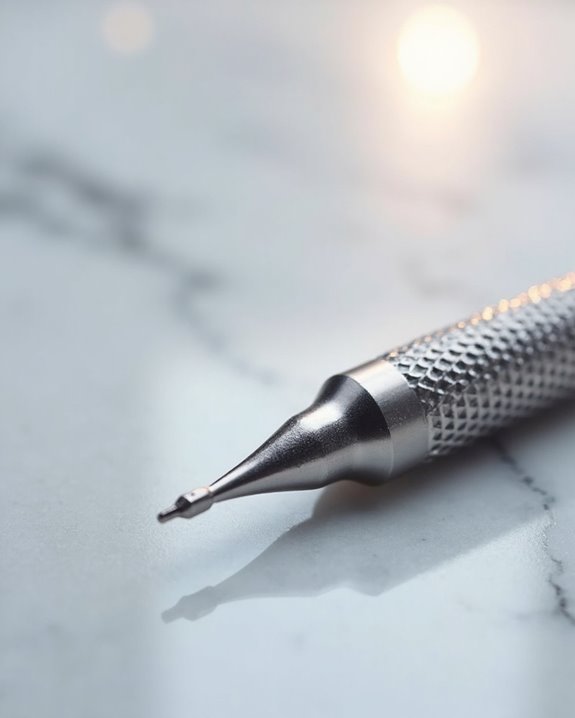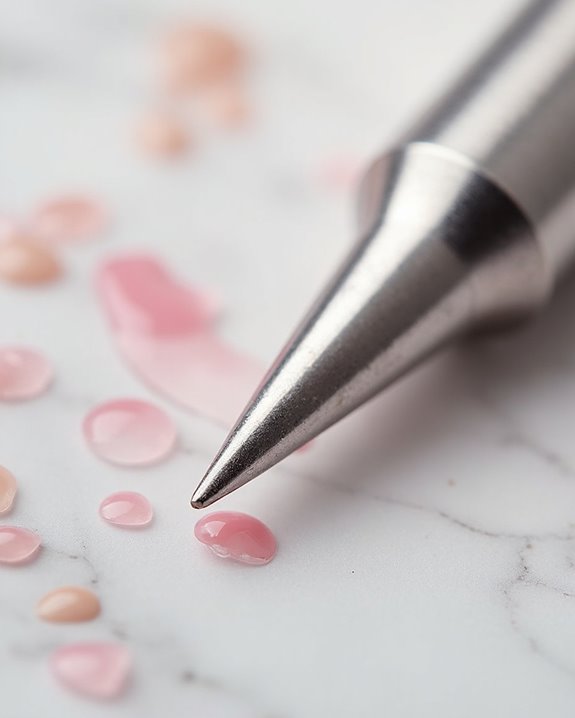Nail drill bits serve specific functions in professional manicure services. Barrel bits shape and shorten nails, cone bits address cuticle areas, while diamond-coated options provide durability for abrasive tasks. Materials vary purposefully: carbide handles heavy-duty acrylic removal, ceramic offers gentleness for natural nails, and different grits determine aggressiveness. The appropriate bit selection depends on task requirements, nail type (natural versus enhanced), and desired finish. Proper technique, combined with regular cleaning and maintenance, guarantees ideal performance and client safety.
Key Takeaways
- Barrel bits shape nail surfaces and create smile lines while cone bits safely work around cuticles and on toenails.
- Carbide bits efficiently remove acrylic or gel enhancements while ceramic bits gently work on natural nails.
- Coarse grit bits quickly remove product while fine grit bits provide finishing touches and polish.
- Diamond-coated bits offer superior durability for professional services with reduced heat generation during use.
- Mandrel bits hold interchangeable sanding bands of various grits for versatility in nail preparation and finishing.
5 Second-Level Headings for “What Are Nail Drill Bits Used For? Essential Guide to Their Functions”
When organizing a detailed guide on nail drill bits, effective second-level headings serve as essential navigational elements that help readers quickly locate specific information they need. A thorough guide should include “Types of Nail Drill” bits, highlighting the differences between barrel, cone, and diamond bits for specific functions like removing product or cleaning the cuticle area. “Materials and Grits” can address how carbide bits differ from ceramic options, and why coarse bit designs remove material quickly while fine bit options provide finishing touches. “Uses for Natural Nails vs. Enhancements” helps distinguish appropriate techniques for different nail types, while “Cleaning and Maintenance Methods” guarantees proper sanitization. Finally, “Selecting the Right Bit” guides readers in choosing compatible bits for their electric file based on shank size and intended application. Moreover, incorporating knowledge about advanced materials like YG6X tungsten carbide can enhance the guide by emphasizing options that provide exceptional resistance to wear and high temperatures.
Types of Nail Drill Bits and Their Materials
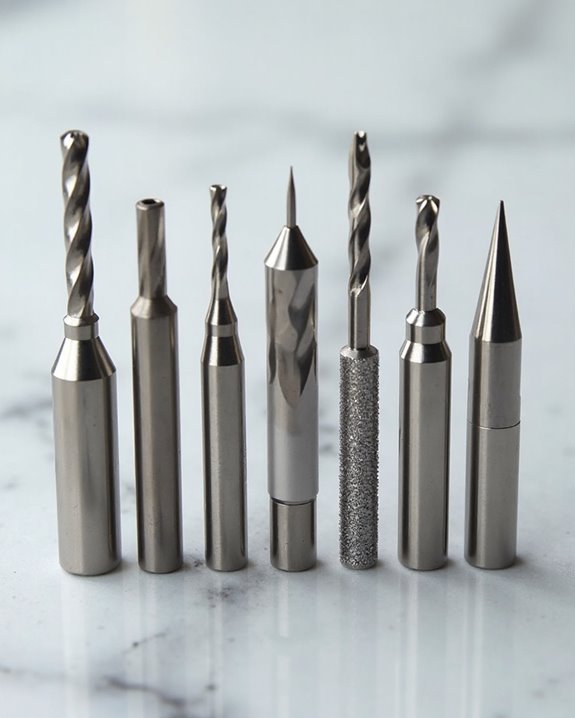
The foundation of any professional nail technician’s toolkit lies in understanding the diverse materials and constructions that comprise modern nail drill bits. Nail drill bits come in a variety of materials, each serving specific functions in nail care procedures. Mandrel bits, typically metal or rubber-based, act as holders for disposable sanding bands available in different grits for smoothing surfaces. Carbide nail drill bits, constructed from durable gold or silver-finished metal, excel at heavy-duty tasks like acrylic removal. Ceramic bits feature specialized flute cuts that minimize heat during operation, making them ideal for precision work. Diamond-coated bits, commonly found in cone bit and barrel bits configurations, provide enhanced durability through their abrasive texture. Different materials of nail drill bits determine their longevity, application, and effectiveness in professional nail services. Moreover, ceramic bits offer gentleness on natural nails while effectively shaping and smoothing acrylic or gel extensions.
Understanding Drill Bit Shapes and Their Specific Purposes
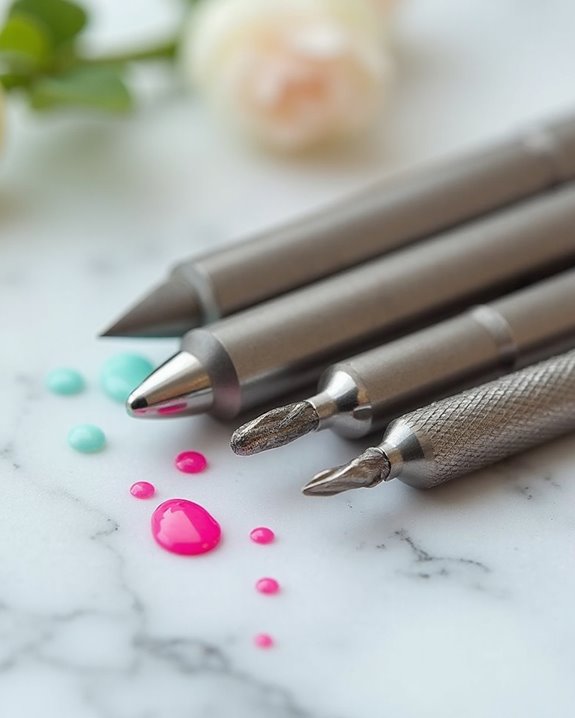
Beyond the materials used in their construction, nail drill bits come in distinct shapes that serve highly specialized functions in nail care applications. The barrel or cylinder bit excels at surface work, including shortening, shaping, and creating smile lines, while never being used in the cuticle area. UNC or needle bits, with their pointed design in different shapes and sizes, effectively clean sidewalls and access tight spaces under nails. Ball top bits target hard skin and remove loose cuticle from the nail plate. Cone bits, featuring a tapered design, prepare cuticle areas and work well on toenails. Safety bits, rounded at the top, provide protection when removing product near cuticles and sidewalls, allowing technicians to work confidently without damaging the natural nail during maintenance procedures. Moreover, flame-shaped bits are ideal for precision work around cuticles and in curved areas to achieve detailed results without excessive heat buildup.
Choosing the Right Grit for Different Nail Services
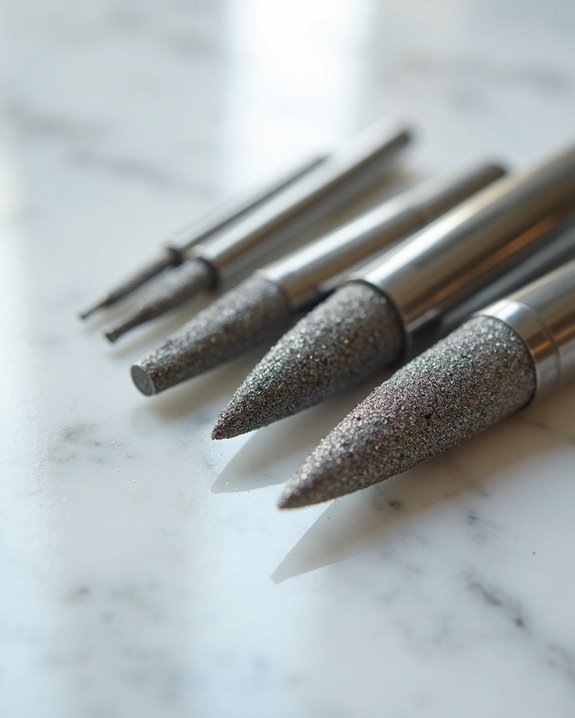
Selecting appropriate grit levels for nail drill bits represents a critical factor in achieving best results while maintaining nail integrity during various services. Coarse grit bits, featuring larger abrasive particles, excel at rapid product removal for acrylics, dip powder, and gels, operating efficiently at higher speeds in professional settings. Medium grit bits provide balanced control for maintenance tasks such as in-fill work and addressing lifted areas without compromising natural nail structure. Fine grit bits, with their smaller particles, deliver gentle surface preparation and finishing touches for manicures and pedicures at 3,000-5,000 RPM, ensuring a polished appearance. Nail technicians should strategically match grit to specific requirements: coarse for speed, medium for everyday versatility, and fine for precision work, adapting their drill bit selection to maximize effectiveness while minimizing potential damage.
Essential Techniques for Safe and Effective Drill Bit Use

Mastering essential techniques with nail drill bits requires careful attention to both safety protocols and operational fundamentals, which form the foundation for professional nail services. Technicians should select the appropriate level of grit based on experience, with Fine texture and Medium texture options being safest for beginners as this prevents damage to natural nails. When working in the cuticle area without damaging tissue, use bits that are rounded at the top and maintain lower RPM settings between 3,000-5,000. To properly prepare the nail bed, practitioners must hold the drill at a 45-degree angle and move continuously across the surface. After each service, thoroughly clean bits using a liquid disinfectant followed by UV sterilization to prevent infection transfer and maintain peak performance.
Frequently Asked Questions
What Are Nail Drill Bits Used For?
Nail drill bits are essential for nail shaping, buffing, cuticle care, acrylic removal, and gel polish application. They serve as efficient pedicure tools and manicure techniques in both salon uses and home application, requiring proper bit maintenance.
What Are the Functions of Drilling Bits?
Drilling bits serve multiple functions, including precision drilling, material removal, and surface finishing with proper depth control. Quality bits guarantee speed efficiency and proper torque handling, while regular bit maintenance and safety protocols prevent accidents.
What Are Different Drill Bits Used For?
Different drill bits serve specific functions: Masonry bits for concrete tools, wood drilling requires specialized bits, metal cutting needs durable options, while tile bits, glass drilling tools, plastic bits, step drills, Forstner tools, and countersink bits fulfill unique applications.
What Are General Purpose Drill Bits Used For?
Like a trusty Swiss Army knife, general purpose drill bits excel in wood drilling, plastic boring, metal piercing, and screw installation. They handle hole enlargement and DIY projects with proper speed adjustment, depth control, and torque settings.


